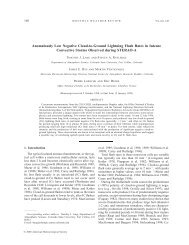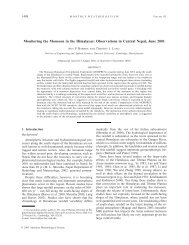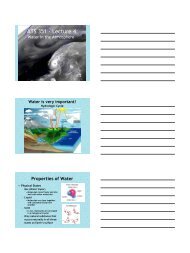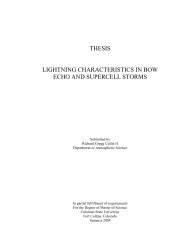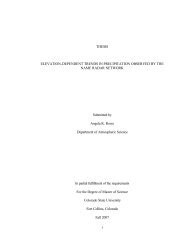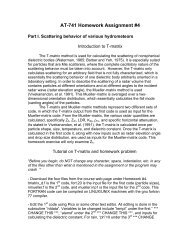1 A dual-polarization radar hydrometeor classification algorithm for ...
1 A dual-polarization radar hydrometeor classification algorithm for ...
1 A dual-polarization radar hydrometeor classification algorithm for ...
Create successful ePaper yourself
Turn your PDF publications into a flip-book with our unique Google optimized e-Paper software.
306307308309310311312313314315316317318319320321322323324325326327328in Fig. 1 and the rest of this study) as opposed to the small oscillations consistent with liquidraindrops de<strong>for</strong>ming as they fall, the additional decrease in Z h is nearly zero but there is a 25%further decrease in both K dp and Z dr . While it is obvious that these three <strong>radar</strong> variables shoulddecrease once rain has completely frozen, these findings show that the dielectric factor anddensity decrease from liquid to ice dominates these trends, canting has a secondary, nonnegligibleeffect, and temperature has little importance.More importantly, since Figs.1 and 2 show how <strong>radar</strong> variables associated with strati<strong>for</strong>mrain encompass that of both supercooled and frozen rain, these latter two phenomena couldsimply be attributed to light rain. If the expected value ranges of a <strong>hydrometeor</strong> type are notunique from another type, fuzzy logic HCA MBFs cannot distinguish them. This simple<strong>algorithm</strong> also cannot accommodate detection of the localized, small magnitude refreezingsignature associated with the production of sleet because those expected value ranges also liewithin that of strati<strong>for</strong>m rain (Kumjian et al. 2013). These include an increase in Z dr and K dpalong with decreased ! hv and Z H . If 2-D MBFs (Zrnic et al. 2001) and/or texture fields (Ryzkovet al. 2005b) were incorporated into the decision process, the spatial, correlated variability in ! hv,Z dr, K dp, and Z h within the refreezing signature might prompt more accurate rain/freezingrain/sleet <strong>classification</strong>. In the meantime, our methodology relies primarily on temperature toclassify rain and the combined possibility of sleet and/or freezing rain below the melting layerwhere T < 0 C without assessing other possible thermodynamic factors as in Schuur et al. (2012).4. Algorithm development and testingThe fuzzy-logic <strong>hydrometeor</strong> <strong>classification</strong> <strong>algorithm</strong> described in DR09 was adapted <strong>for</strong>winter precipitation types to include strati<strong>for</strong>m rain, freezing/frozen raindrops (i.e., sleet and/orfreezing rain), wet snow (indicative of the melting layer), aggregates, dendrites, and plates.15



